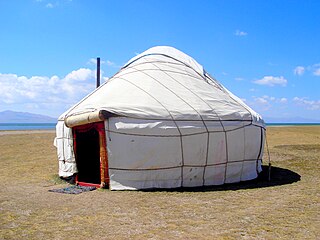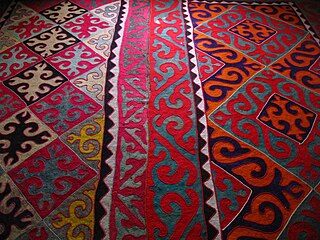
Bishkek, formerly Pishpek and Frunze, is the capital and largest city of Kyrgyzstan. Bishkek is also the administrative centre of the Chüy Region. The region surrounds the city, although the city itself is not part of the region but rather a region-level unit of Kyrgyzstan. Bishkek is situated near the Kazakhstan–Kyrgyzstan border with its population being 1,074,075 in 2021.

Kyrgyzstan, officially the Kyrgyz Republic, is a landlocked country in Central Asia, lying in the Tian Shan and Pamir mountain ranges. Bishkek is the capital and largest city of the country. Kyrgyzstan is bordered by Kazakhstan to the north, Uzbekistan to the west, Tajikistan to the south, and China to the east and southeast. Ethnic Kyrgyz make up the majority of the country's seven million people, followed by significant minorities of Uzbeks and Russians.
Kyrgyz music is nomadic and rural, and is closely related to Turkmen and Kazakh folk forms. Kyrgyz folk music is characterized by the use of long, sustained pitches, with Russian elements also prominent.

The flag of the Kyrgyz Republic consists of a red field charged with a yellow sun that contains a depiction of a tunduk, the opening in the center of the roof of a yurt. It is actually a depiction of the first thing one sees when waking up in a yurt, namely the construction of the pinnacle of every Kyrgyz yurt with three crisscrossing laths across the circular opening at the top of the yurt. Adopted in 1992, just over seven months after the country's independence was declared, to replace the flag of the Kirghiz Soviet Socialist Republic (SSR), it has been the flag of the Kyrgyz Republic since that year. The red on the flag is said to be inspired by the pennant lifted by Manas, the country's folk hero.

A yurt or ger (Mongolian) is a portable, round tent covered and insulated with skins or felt and traditionally used as a dwelling by several distinct nomadic groups in the steppes and mountains of Inner Asia. The structure consists of a flexible angled assembly or latticework of wood or bamboo for walls, a door frame, ribs, and a wheel possibly steam-bent as a roof. The roof structure is sometimes self-supporting, but large yurts may have interior posts supporting the crown. The top of the wall of self-supporting yurts is prevented from spreading by means of a tension band which opposes the force of the roof ribs. Yurts take between 30 minutes and 3 hours to set up or take down, and are generally used by between five and 15 people. Nomadic farming with yurts as housing has been the primary life style in Central Asia, particularly Mongolia, for thousands of years.

The culture of Mongolia has been shaped by the country's nomadic tradition and its position at the crossroads of various empires and civilizations. Mongolian culture is influenced by the cultures of the Mongolic, Turkic, and East Asian peoples, as well as by the country's geography and its history of political and economic interactions with other nations.

Tush kyiz are large, elaborately embroidered wall hangings, traditionally made in Kyrgyzstan and Kazakhstan by women to commemorate the marriage of a son or daughter. Colors and designs are chosen to symbolize Kyrgyz traditions and rural life. Flowers, plants, animals, stylized horns, national designs and emblems of Kyrgyz life are often found in these ornate and colorful embroideries. Designs are sometimes dated and signed by the artist upon completion of the work, which may take years to finish. The tush kyiz is hung in the yurt over the marriage bed of the couple, and symbolize their pride in their Kyrgyz tradition.

The culture of Kyrgyzstan has a wide mix of ethnic groups and cultures, with the Kyrgyz being the majority group. It is generally considered that there are 40 Kyrgyz clans, symbolized by the 40-rayed yellow sun in the center of the flag. The red lines inside the sun visualise the crown of a yurt, the traditional dwelling of nomadic farmers, once the main population of the Central Asian area. The dominant religion of Kyrgyzstan is Sunni Islam (91%). The Russian population is Russian Orthodox.
Although Kyrgyzstan’s mountains and lakes are an attractive tourist destination, the tourism industry has grown very slowly because it has received little investment. In the early 2000s, an average of about 450,000 tourists visited annually, mainly from countries of the former Soviet Union. In 2018, the British Backpacker Society ranked Kyrgyzstan as the fifth best adventure travel destination on earth, stating that the country was an adventure travel secret that is "bound to get out soon."

Dance in Indonesia reflects the country's diversity of ethnicities and cultures. There are more than 1,300 ethnic groups in Indonesia. Austronesian roots and Melanesian tribal forms are visible, and influences ranging from neighboring Asian and even western styles through colonization. Each ethnic group has its own dances: there are more than 3,000 original dance forms in Indonesia. The old traditions of dance and drama are being preserved in the many dance schools which flourish not only in the courts but also in the modern, government-run or supervised art academies.
Durdy Bayramov was a Turkmen academician and artist who was awarded the highest honorary title in his country: "People's Artist of Turkmen SSR". In his native Turkmen language, Durdy Bayramov's name is simply "Durdy Bayram". The name "Bayram" means "celebration" in Turkic languages.

A shyrdak or syrmak is a stitched, and often colourful felt floor- and wallcovering, usually handmade in Central Asia. Kazakhs and Kyrgyz alike traditionally make shyrdaks, but especially in Kyrgyzstan, the tradition is kept alive, and products are also sold to tourists.

Ala kiyiz or tekemet is an ornamenting style for textile floor- or wallcovering made by pressing wet, soaped wool of various colours together to make it felt. The chemical process of felting transforms the loose woolen fibers into a thick cloth. The felt carpet-making technique is a traditional folk art among the nomadic farming Kazakh, Kyrgyz and Mongolian peoples of the Tien Shan mountains and the steppes in Central Asia for over two and a half thousand years. From the various methods of ornamenting, ala kiyiz is among the widest spread, with shyrdak.

The Kyrgyz are a Turkic ethnic group and one of the 56 ethnic groups officially recognized by the People's Republic of China. Mainly distributed in Kizilsu Kyrgyz Autonomous Prefecture, in the southwest of Xinjiang Uyghur Autonomous Region, a few Kyrgyz communities reside in neighboring Uqturpan, Aksu, Yarkant, Yengisar, Taxkorgan and Pishan. According to the fifth national census of the People's Republic of China conducted in 2000, there are 160,875 Kyrgyz people in China.

Darkestrah is a Kyrgyz pagan metal band, formed in 1999 in Bishkek, Kyrgyzstan. Throughout their career the band has blended folklore music with metal elements. In its lyrics and in musical composition, the band uses national folk musical instruments, such as the komuz and kyl-kyak, and references shamanism and Tengrism. The band also takes influence from genres such as progressive rock and post-rock, generally constructing lengthy, rhythmically complex songs that often feature several discrete movements.

It is quite difficult to define Indonesian art, since the country is immensely diverse. The sprawling archipelago nation consists of 17.000 islands. Around 922 of those permanently inhabited, by over 1,300 ethnic groups, which speak more than 700 living languages.

The Ala Archa State Residence is an official presidential residence in Bishkek, Kyrgyzstan. It is the current official home of the President of Kyrgyzstan Sadyr Japarov.

Kasymaly Jantöshev was a Kyrgyz writer and playwright. Jantöshev is regarded as one of the most important Kyrgyz writers, and is considered to be one of the founders of Kyrgyz drama and theatre. Many of his works portray the transformation of Kyrgyz society during the 20th-century, and contain socialist themes. One of Jantöshev's novels, Kanybek, has become part of Kyrgyzstan's cultural heritage, and remains very popular within the country.

Marwar painting is a traditional form of Indian painting that originated in the city of Jodhpur in the Indian state of Rajasthan. It is known for its vibrant colors and intricate designs, which reflect the rich cultural heritage of the region. Even though it emerged under the larger umbrella of Rajput painting, Marwar School created an original style as it was partly influenced by Mughal art and showcased many original elements. Marwar school of painting manifested distinct style, content, and techniques of its own that incorporated local knowledge.














